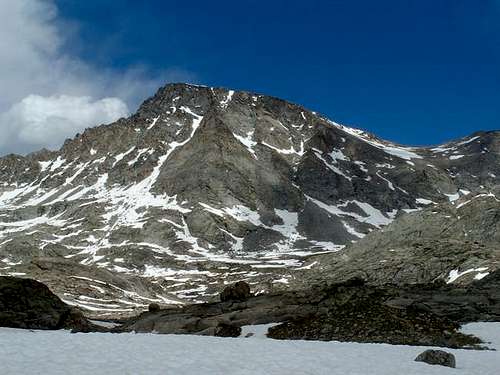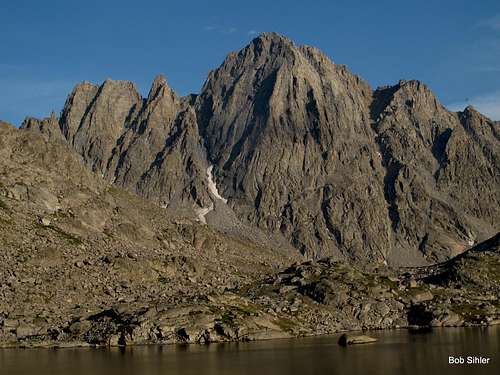-
 16967 Hits
16967 Hits
-
 82.93% Score
82.93% Score
-
 16 Votes
16 Votes
|
|
Area/Range |
|---|---|
|
|
43.10467°N / 109.61181°W |
|
|
Hiking, Mountaineering, Trad Climbing, Bouldering, Scrambling |
|
|
Summer |
|
|
Indian Basin-- Wind River Range, Wyoming
Overview
For this page's purposes, the peaks of Indian Basin will be those named ones immediately surrounding it and usually or most logically approached from the basin itself.
Reaching Indian Basin is no light undertaking. Depending on the source you consult, you will find that it is anywhere from 11.5-13 miles to what this page considers to be the beginning of the basin, which is shortly past a junction where one heads left for Titcomb Basin or continues straight for Indian Basin. Most parties seem to take two days to reach the basin, spending the first night somewhere between halfway or 2/3 in at Hobbs Lake or Seneca Lake, but if you're in solid shape, I recommend sucking it up and heading all the way in on Day 1 or at least getting to Island Lake; you will in retrospect be glad for the extra full day of climbing, hiking, and/or exploring.
The peaks here are for mountaineers. All are at least Class 3 by their easiest routes.
In general, it probably is neither necessary nor useful to make pages for every basin or cirque in a mountain range, but considering this location's next-door proximity to Titcomb Basin and all the excellent climbing objectives clustered around it, it seems to make sense to offer this page to help with planning and logistics.
Getting There
There are all sorts of different approaches one can take, but by far, most people use the one from Elkhart Park.
Hiking In
Peaks and Routes
Peaks in bold have SP pages and are attached as children to this page.
- Fremont Peak-- 13,745'-- Class 3 via SW buttress. Bonney calls it Class 4, but it is not unless you make it so. In my opinion, it is really Class 2+.
- Jackson Peak-- 13,517'-- Class 3 via SE face and ridge
- Knife Point Mountain-- 13,001'-- Class 4 by E or W ridge; 5.0 via NW ridge. A Class 3 route also exists via a SW couloir but is not approached from Indian Basin (that is not to say doing so is impossible).
- Notch Pinnacle-- 12,498'-- Class 4 via west ridge
- Ellingwood Peak (Harrower Peak)-- 13,052'-- Class 4 via south ridge (according to Bonney though I felt it was more Class 3 with a touch of 4 here and there); 5.6 or 5.7 (depending on source) via north arete (classic area route).
- Elephant Head (Cairn Peak)-- 12,160'-- Class 4 via SE ridge or Class 3 via S slopes and couloir (Bonney refers to these as the East Ridge and East Side, respectively, and calls both Class 4). Although one can use Indian Basin to approach these routes, it is easier to do so from the other side of the peak.
- Nebraska Point-- 12,935'-- Class 4 via west ridge
- Faler Tower-- 12,607'-- 5.5 via north ridge
Map of Indian Basin
Camping
Where you camp is up to you based on your itinerary. Island Lake makes a good base camp because routes to Titcomb Basin, Indian Basin, and other areas nearby all branch out from it. If you don't camp at Island Lake and if Indian Basin is your primary destination, then consider the extra hike into the basin to set up camp. However, be aware that finding good legal campsites can be tricky because you are required to camp at least 200' from lakes. Also, there is almost no shelter in Indian Basin, and wood fires are not allowed. Regardless, if you are going to be doing a lot of climbing here as opposed to just one or two peaks, you're going to want to camp in the basin and cut down on the daily back-and-forth hiking.
Note: you might look at a map and think that camping by the junction of the trails into Titcomb and Indian Basins is the way to go, but it isn't. The ground is rocky and uneven there.
Red Tape
Just read posted wilderness regulations, especially regarding campsites and fires.










